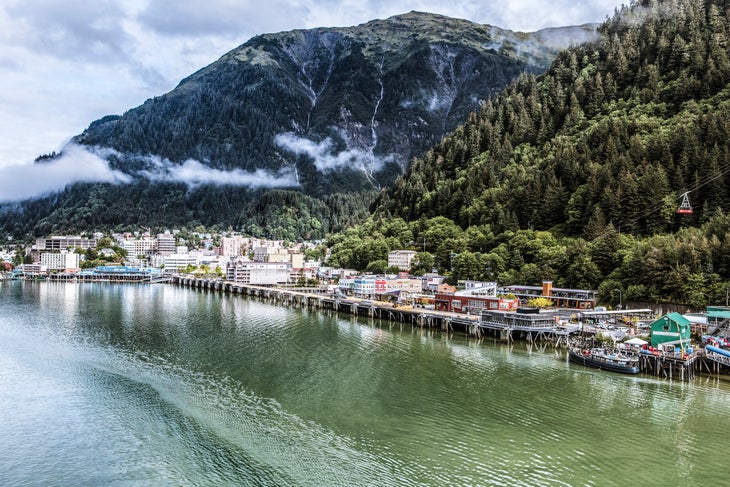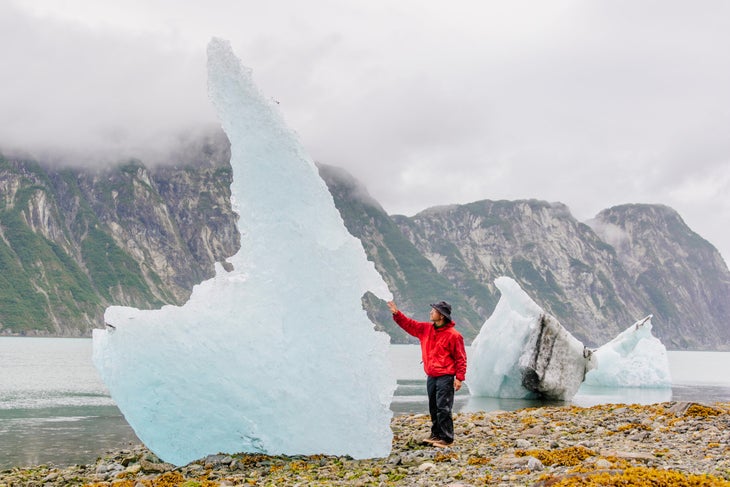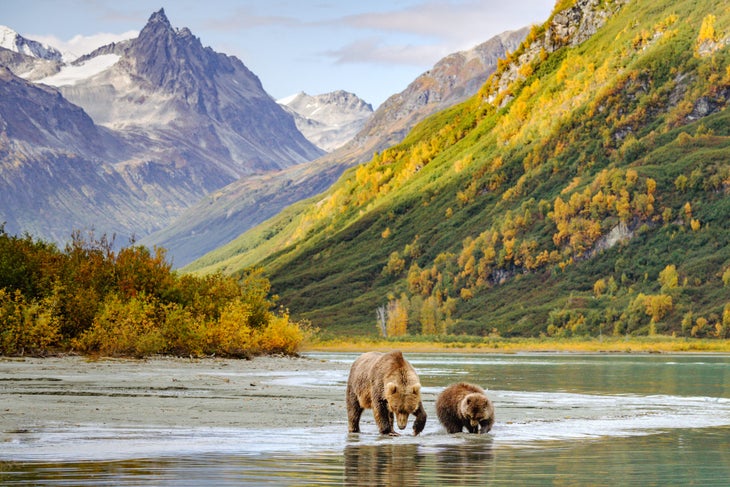No products in the cart.
Outdoor Adventure
The Alaska Ferry System is a Gateway to Incredible Hiking
I visited Alaska last summer. Lucky me, right? Only, I was on the kind of massive tour boat that provides grand views of the backcountry, but frustratingly little time to do anything aside from just gawp at it. When my ship pulled into Skagway Harbor, I looked longingly at the high peaks and forests, and thought: “I shall return.”
But on an Alaska State Ferry, next time. It provides no-crowd, low-cost (once you reach Alaska, that is) access to some of the most remote, beautiful trailheads, beaches, streams, and lakes in the land. It suffers all the vagaries of local transit, with service interruptions and cancellations. But if you have the time and patience to go slow, there’s no better way to see Alaska.
My ship—Holland America’s Nieuw Amsterdam—had a population of 3,000, while Skagway is inhabited by only 1,100 people. We overwhelmed them. But after a few hours pawing the knickknacks in town, we were herded back on board, the captain blew our big horn, and we sailed away.
“For a lot of Backpacker readers, that will be a great moment,” says Jennie Flaming, an adventure planner and voice of the Alaska Uncovered podcast. “When the cruise ships leave, the locals take over, and you can learn what Alaska is all about.”
Flaming is all about local flavor and color, and you can’t get more local or flavorful than the Alaska Marine Highway System.
The Alaska State Ferry—as it is also known—is as different from the Nieuw Amsterdam as Campbell’s Soup is from vichyssoise. And that’s a good thing. It’s the ferry of the people, connecting 3,500 miles of rugged coastline, 30 rugged towns, and the rugged people who live in them. According to the AMHS website, it’s the only marine route recognized as National Scenic Byway and All-American Road.
Ready to hop aboard? Flaming, who loves the ferry system, advises a bit of caution.
“Compared with a cruise ship, this is a Greyhound bus,” she says. “It’s transportation for people who don’t need a lot of amenities. There’s no cell service or wifi. It’s Backpacker, not Conde Nast Traveler.”
Sounds perfect, if you ask me. Imagine a $466, 3-day cruise from Bellingham, Washington, to Juneau, Alaska—a great jumping off point for further ferry or foot exploration.
Long-haul Alaska ferries have a designated area where you can pitch your tent and while away your chug from here to there. You use a towel to dry your tent’s footprint, duct-tape it to the deck, and then toss all your gear inside so your tent doesn’t blow away in the 35-knot winds that will rake the boat when you’re underway. Long-haul ferries are equipped with showers, coin-op laundries, and—on the bigger ships—cafeterias where you can buy a beer and salmon burger, and meet the locals.
Here’s the guarantee: The views will be sublime, and you’ll have plenty of time to admire them when the summer sun shines for eighteen hours. And that also means oceans of opportunity to download town and trail beta from your neighbors on the tent deck.
But where will the ferry take you? It’s a big state, and the possibilities are nearly endless.
For Dayhikers
You don’t usually depend on the D.O.T. for trail intel, but then, Alaska is no ordinary place. Sam Dapcevich, an information officer for the State Ferry, has plenty of ideas where you should take your warmup hikes.
If you don’t have time for the ferry ride from Bellingham, you might fly into Juneau, with its international airport and plenty of hikes nearby. It’s a good place to stock up on food and bear spray for your adventure, and it has good access to the ferry system when you’re ready for more.

For an initial leg stretcher, head for the Mt. Roberts trailhead at the end of Basin Road, a mile walk from downtown, and you won’t even need to rent a car.
“A good short loop is the East Glacier Trail, 5 miles from the airport in Juneau,” says Dapcevich. “It’s about 3.5 miles and has beautiful vistas and forest scenery. There’s some history from mining in the area too.”
Flaming recommends taking the tram from downtown Juneau to the top of Mt. Roberts, which has incredible views on a clear day. Then hike from the top of the tram to Gastineau Peak for the views and wildflowers, which bloom from June to August. Ready for more? Now hop the ferry for the six-hour scenic route from Juneau to Gustavus, the diminutive capital of Glacier Bay National Park.
For Glacier Hounds and Kayak Trekkers
If you’ve traveled the tourist circuit, your mental image of Alaska may be of enormous cruise ships and clueless flatlanders, and they are in fact like fleas on dogs near the ferry docks. But if you manage to escape those jumpoff points, you’ll escape the crowds too.
“Ninety-six percent of the people who visit Glacier Bay National Park are on a cruise ship,” says Flaming. “It’s a fantastic destination for independent travelers by ferry.”

The Bartlett Cove campground is never full, according to Flaming, and the 4.5-mile Bartlett River Trail is one of her “must-dos.” If you really want to experience Glacier Bay, join a guided kayak tour, or plan your own. You can rent sea kayaks or join a tour offered by Alaska Mountain Guides, Glacier Bay Sea Kayaks, or Spirit Walker Expeditions. If you want to get up close and personal with bergy bits and growlers (the bushel-basket-sized ice boulders that cascade off of glaciers), this is the place for you.
For Angler-Hikers
Ditch the freeze-dried dinners and catch your own on a visit to Sitka. If you hop on a ferry in Juneau, you’ll be there in a mere nine hours. Dapcevich notes that there are plenty of trails that lead out of town, and good trout fishing from the lakes that you’ll find along them. In the summer, you can make like a brown bear and fish for salmon from the beaches. If you’re after altitude, he cites Gavan Hill and Harbor Mountains as a great 12-mile round trip up to the high peaks inland, with spectacular views of the Alexander Archipelago to the south. Camp at Starrigavan and use it as your jumping off point for exploring the Tongass National Forest, the nation’s largest.
Flaming recommends these hikes in Sitka, for the non-anglers among you: First, check in with the Sitka Trail Works, to learn about the extensive trail system they’re creating and for local intel. On a clear day, head 2 miles up to Picnic Rock, with views of downtown Sitka and the pyramidal peak of Mt. Verstovia, a perilous scramble for sure-footed hikers. In the rain (likely), take the Indian River Trail 4.5 miles to a no-doubt gushing waterfall.
For the Trip of a Lifetime
Flaming doesn’t hesitate: “It’s the Chilkoot Trail,” she raves. “I can’t imagine too many more spectacular backpacking experiences.” You’ll catch a six-hour ferry north from Juneau to Skagway, and hitch a ride out to the trailhead near Dyea Campground. It’s a 33 mile hike to Lake Bennett, in Canada, gaining about 4,000 feet of elevation and moving through eight distinct climate zones.
“It’s like a wilderness-gold rush museum,” says Flaming. “It’s a national historic park run by the U.S. National Park Service and Parks Canada, so you’ll find interpretive signs along the way, and a cast iron stove from the 1890s, abandoned by a gold miner.”
Once you reach trail’s end, you can hop on the White Pass Yukon Railroad to return to Skagway. Not up for the five-day trip? You can book whistle-stops on the Yukon Railroad, and ride to a dayhike destination. The 6-mile Denver Glacier trail will take you through hemlock forest, past Glacier Lake, all the way to the hanging blue ice of Denver Glacier. Book an overnight in the Denver Caboose Cabin, and take turns playing conductor when you’re not soaking up the glacier views.
More Ports, More Hikes
Headed elsewhere on the Alaska State ferry? Here are the best trails in other ports:
Ketchikan: The 2-mile Rainbird Trail, through towering forests, or the 10-mile traverse between Carlana and Persevereance lakes, which climbs over Juno and Ward mountains.
Haines: Take the 6-mile round trip to Battery Point for water views, or Mt. Riley, a 5-mile out-and-back with the big views you came to Alaska for.
Seward: For dreamers and trail activists, consider the Alaska Long Trail, which exists in bits and pieces on the 167-mile trip from Seward up to Eagle River, and then on to Denali National Park. The goal is to extend the trail all the way up to Fairbanks, for a total of 500 miles.
Safety

This wouldn’t be an article about Outdoor Alaska without some timely warnings, and Flaming offers them. Carry bear spray and stay vigilant for the big wildlife (bears, wolves, moose) and the tiny predators as well: mosquitos.
You’ll need another sort of protection on an Alaska trip, as well: Travel insurance.
“It’s super important,” she warns, “if your ferry is canceled, or if you’re stuck somewhere you don’t want to be. It’s confusing, and the schedule is weird.” Flaming shops the insurance marketplace insuremytrip.com before she boards a vessel for the unpredictable Great North.
Another must: Be ready for rain.
“Test the rainfly on your tent in the shower before you go, buy waterproof footwear, and lay out for a new rain jacket and pants,” says Flaming. “Mentally prepare yourself for being a little damp, even on sunny days. The coast is a rainforest, so the woods will be soaking.”
Hey, if you launch your adventure by ferry, you’ve got to expect water, water, everywhere—flowing, falling, tidal, and frozen. But wet is wild, and Alaska’s hiking trails are as wild as they come.
Source link

